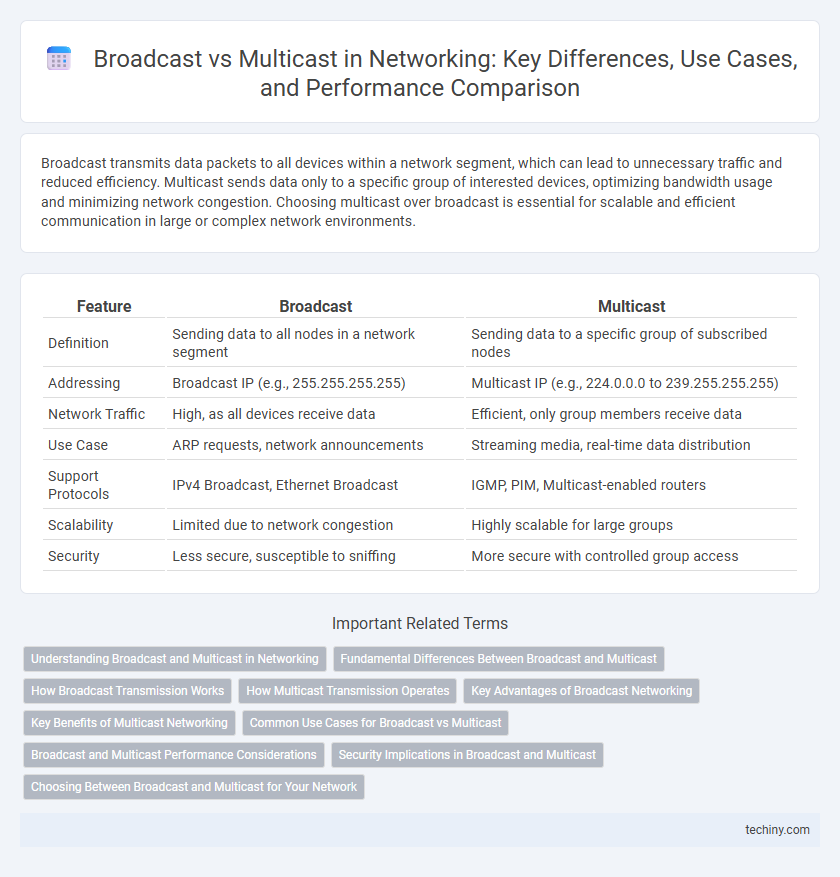Broadcast transmits data packets to all devices within a network segment, which can lead to unnecessary traffic and reduced efficiency. Multicast sends data only to a specific group of interested devices, optimizing bandwidth usage and minimizing network congestion. Choosing multicast over broadcast is essential for scalable and efficient communication in large or complex network environments.
Table of Comparison
| Feature | Broadcast | Multicast |
|---|---|---|
| Definition | Sending data to all nodes in a network segment | Sending data to a specific group of subscribed nodes |
| Addressing | Broadcast IP (e.g., 255.255.255.255) | Multicast IP (e.g., 224.0.0.0 to 239.255.255.255) |
| Network Traffic | High, as all devices receive data | Efficient, only group members receive data |
| Use Case | ARP requests, network announcements | Streaming media, real-time data distribution |
| Support Protocols | IPv4 Broadcast, Ethernet Broadcast | IGMP, PIM, Multicast-enabled routers |
| Scalability | Limited due to network congestion | Highly scalable for large groups |
| Security | Less secure, susceptible to sniffing | More secure with controlled group access |
Understanding Broadcast and Multicast in Networking
Broadcast in networking sends data packets to all devices within a network segment, creating high traffic and potential inefficiencies. Multicast targets a specific group of devices interested in receiving the data, optimizing bandwidth by reducing unnecessary transmissions. Understanding these methods helps improve network performance and resource allocation.
Fundamental Differences Between Broadcast and Multicast
Broadcast transmits data packets to all devices within a network segment, consuming bandwidth regardless of whether recipients need the information, while multicast delivers data only to a specific group of interested devices, optimizing network efficiency. Broadcast operates at Layer 2 using broadcast MAC addresses, flooding all nodes in the broadcast domain, whereas multicast uses designated multicast MAC addresses and Internet Group Management Protocol (IGMP) to manage group membership dynamically. The fundamental difference lies in broadcast's indiscriminate data delivery to all hosts versus multicast's selective delivery to subscribed devices, reducing unnecessary network traffic and improving performance.
How Broadcast Transmission Works
Broadcast transmission works by sending a single data packet to all devices within a network segment, utilizing the broadcast address to reach every node simultaneously. This method consumes more bandwidth as every device processes the packet regardless of whether it is the intended recipient, leading to possible network congestion. Commonly used in local area networks (LANs), broadcast transmission facilitates tasks like address resolution protocol (ARP) requests and network discovery.
How Multicast Transmission Operates
Multicast transmission operates by sending a single data stream to multiple receivers simultaneously using multicast IP addresses, reducing bandwidth consumption compared to broadcast. Routers use Internet Group Management Protocol (IGMP) to manage group membership, ensuring data is only delivered to devices that have joined the multicast group. This selective distribution enhances network efficiency, minimizes traffic, and supports optimized communications in applications like IPTV and video conferencing.
Key Advantages of Broadcast Networking
Broadcast networking enables efficient data delivery to all devices within a network segment, ensuring universal message receipt without the need for multiple transmissions. It simplifies network management by eliminating the necessity to track individual device addresses, reducing overhead in small to medium-sized networks. Broadcast is particularly advantageous for services like ARP and DHCP, where simultaneous communication to multiple nodes is essential.
Key Benefits of Multicast Networking
Multicast networking efficiently delivers data to multiple recipients simultaneously, reducing bandwidth consumption compared to broadcast methods that send data to all devices regardless of necessity. It enhances network scalability by limiting traffic to only interested receivers, minimizing congestion and optimizing resource usage. This targeted data distribution improves overall network performance and supports applications such as live streaming, video conferencing, and real-time data dissemination with high precision.
Common Use Cases for Broadcast vs Multicast
Broadcast is commonly used in local area networks (LANs) for sending data packets to all devices simultaneously, such as ARP requests and DHCP discovery processes. Multicast suits streaming media distribution, online gaming, and video conferencing where data needs to reach multiple specific recipients efficiently without overloading the network. Enterprises often deploy multicast for IPTV and real-time financial trading platforms to optimize bandwidth and reduce latency compared to broadcast methods.
Broadcast and Multicast Performance Considerations
Broadcast transmits data packets to all devices on a network segment, which can lead to excessive bandwidth consumption and increased network congestion, especially in large networks. Multicast, by sending data only to subscribed devices, optimizes bandwidth usage and reduces unnecessary load on non-targeted hosts. Performance considerations favor multicast for scalable applications like video streaming or online gaming due to its efficient resource utilization and minimized latency.
Security Implications in Broadcast and Multicast
Broadcast communication exposes data to all devices within a network segment, significantly increasing the risk of unauthorized access and potential data interception. In contrast, multicast restricts data transmission to a specific group of authorized recipients, enhancing security by limiting exposure and reducing the attack surface. Implementing encryption and access control mechanisms in multicast environments further strengthens protection against eavesdropping and unauthorized data access, making multicast a more secure option for sensitive network communications.
Choosing Between Broadcast and Multicast for Your Network
Broadcast transmits data to all devices on a network segment, leading to increased traffic and potential congestion, while multicast selectively sends data only to subscribed devices, optimizing bandwidth efficiency. Choosing multicast is ideal for applications like video streaming or real-time conferencing where targeted data delivery reduces unnecessary load on the network. Networks with limited devices or legacy systems may still rely on broadcast, but scalability and performance improvements typically favor multicast implementation.
Broadcast vs Multicast Infographic

 techiny.com
techiny.com